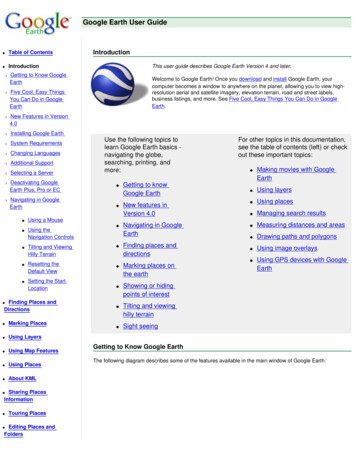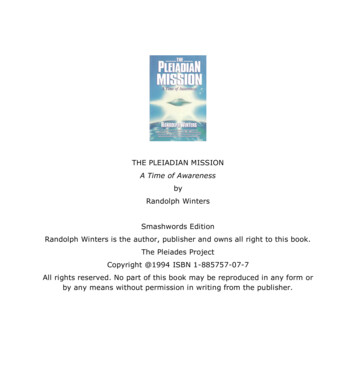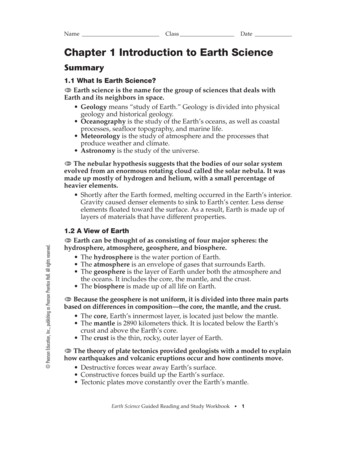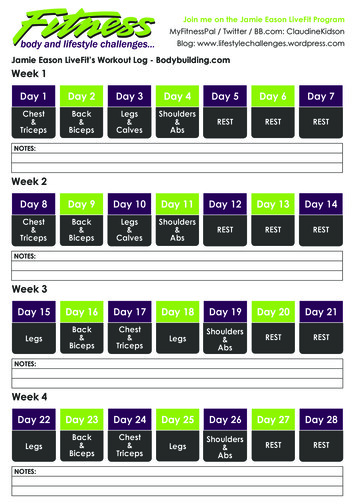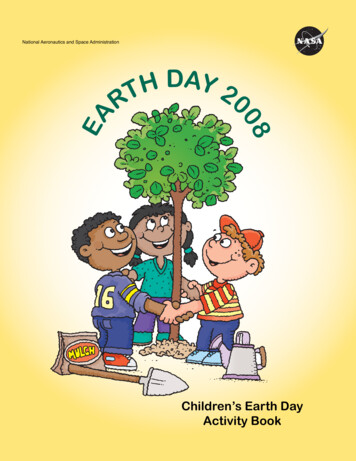
Transcription
DAY 2HT0R08EANational Aeronautics and Space AdministrationChildren’s Earth DayActivity Book
History of Earth DayEarth Day was founded in 1970 by former Governor and Senator of Wisconsin, Gaylord Nelson. Thefirst Earth Day in 1970 rallied over 20 million Americans from around the countryand on college campuses to get involved in environmental “teach-ins.” Thisevent, which was the largest grassroots mobilization in U.S. history,created what has come to be known as the environmental movement. It was out of this event that came the first environmentallegislation—the Clean Air and Water acts.In 1990, more than 200 million people in 141 countriesparticipated during Earth Day’s 20th anniversary. Duein large part to the efforts of hundreds of local organizers, “Earth Day” is now an anticipated annualevent. Earth Day observances and celebrationsnow include all social sectors, nationalities, andcultural groups. Earth Day has become perhaps the most prominent catalyst for ongoingenvironmental education, action, and change.In response to this groundswell of activityin hundreds of U.S. communities, GaylordNelson, Bruce Anderson, and Claes Nolelincorporated Earth Day USA to help facilitatethe contribution of the Earth Day process.In doing so, they advance the environmentalagenda to include year-round activities thatwould “make every day Earth Day.”Earth Day celebrationsof entry to addressconcerns as well asmunities to focus onproblems.offer an important pointworldwide environmentalthe opportunity for comtheir unique environmentalBecause Earth Day observances and celebrationsbroaden the base of support for the environmental programs, rekindle public commitment, and enroll participation from every social and business sector, they can be used toimplement wide-scale programs that bring people together to act for thecommon good. . . Earth Day USAEarth Day Every Day1For the Benefit of All
raEy CommiaDttthNASAGeeretneClenn ResearchThe Earth Day Committee of NASA Glenn Research Center was created in 1993. Its purpose is tohelp educate and enhance the awareness of Glenn employees and the general public regardingNASA’s environmental activities, issues, and concerns. The committee comprises GRC employees allworking together to achieve our mission.Earth Day Every Day2For the Benefit of All
Glossary of Environmental TermsEnvironment: Our environment is everything around us, living and nonliving,including air, water, soil, trees, rocks—even other people and animals. Our environment includes the conditions under which we live, such as weather and altitude.For any living thing, its environment means all of the living and nonliving thingsaround it.Ecology: Studying how living (or nonliving) things interact with and affect theirenvironment. For example, ecology means finding out what happens when humanactivity such as releasing toxins into a stream, or why a certain insect pollinates aflower.Global: Global means the whole world.Greenhouse effect: Greenhouse gases (carbon dioxide, water, vapor, methane,and others) make the Earth warmer by holding the Sun’s warmth in our atmosphere like a blanket. We need the greenhouse effect in order to survive on Earth.Without it, our Earth’s climate would be about 60 F cooler! Greenhouse gases areproduced by the natural processes, such as trees exchanging oxygen for carbondioxide. But human activities, such as burning petroleum (as we do in our cars),can increase these gases. Increasing greenhouse gases increases the greenhouseeffect, warming the Earth more.Global warming: A gradual increase in the world’s average temperature (on theground and in the air). Warming can cause changes in climate, such as changes inrainfall patterns or a rise in sea level. These weather changes or the warming itselfcan affect plants, wildlife, and humans. Usually when global warming is discussed,scientists are talking about increases of greenhouse gases from human activitiessuch as burning fossil fuels like coal or petroleum and deforestation.Climate change: A climate is all of the typical weather events over a long time inwhatever region of the Earth you choose. For example, in northern Ohio, a winter’sday can be sunny and warm. But over many years, Ohio’s average winter days arecold and snowy—that is our climate. Climate changes means a change in theselong-term average weather patterns. The changes can be warmer or colder, or canbe rainy or less rainy. When people are concerned about climate change, it meansthey are worried that many climates seem to be changing all over the world.Recycle: To take back materials for human use that would have been thrownaway. For example, making picnic tables or fleece sweaters from recycled popbottles: or donating old clothing to others, or using them as reusable rags insteadof nonreusable paper towels. We mainly recycle to keep useful materials from becoming garbage in our landfills or as litter. But recycling and reusing (likegiving away clothes you’ve outgrown) also saves money, energy, and water, sincewe don’t have to pull new materials out of the ground and make new products.
Mission to Planet Earth Careers1. Atmospheric chemist: I study the air surrounding the Earth over time to understand what is natural and whathas changed because of pollution. I take samples from aircraft or balloons, conduct laboratory experiments, andcreate computer models.2. Climatologist: I study weather on a big scale over a long period of time—even centuries. I gather samples thatshow long-term histories, like those taken from the bottom of the ocean or from polar ice cores. I also studythe growth rings of trees, and then I predict the future climate.3. Mathematician/computer scientist: I invent and improve computers and programs to study about Earth. Iknow how to create programs on computers that are more complicated than computer games. I make the workof many scientists possible by keeping all the satellite information easy to access and understand.4. Sociologist: I study people in large populations—how they live, grow food, and manufacture things. From whatI learn about large numbers of people, I can help predict what people could do to the environment. My workhelps decision makers make policies that help prevent damage to the environment.5. Ecologist: I study various forms of life on Earth and how they interact. I study entire ecosystems such as wetlands, prairies, and forests. Sometimes I go out in ships or use aircraft and satellites to observe and gather dataabout plants and animals in their habitat. We can learn from observing the abundance of life what changes areoccurring environmentally on Earth.6. Geologist/geophysicist: I study how Earth is formed, what has happened to it since it formed, and what mighthappen to it in the future. I study volcanoes, earthquakes, and landslides. I can study rocks and rock formationsand determine the geological history of an area.7. Climatologist: I study glaciers in the Arctic and Antarctica as well as those formed in the tallest mountains. Istudy satellites and ground measurements to predict the weather. I am like a meteorologist, but I study longterm weather patterns.8. Hydrologist: I study the water cycle. I study where the water goes below ground, on the Earth’s surface, and inthe air. I study what elements it contains, and whether its chemistry has changed. My research often is used todetermine where droughts may occur or how pollutants travel.9. Meteorologist: I study the weather, the local short-term changes that affect how we live every day. I usesatellites and ground measurements to predict the weather. You can see some meteorologists on televisionnews programs.10. Oceanographer: I study oceans and how they change. I analyze the chemical makeup of ocean water, oceanfloor geography, currents, waves, tides, and ocean plants and animals. I work on ships, in laboratories, or inaircraft and use floats and satellites to obtain some of my data.11. Volcanologist: Using ground instruments, I study volcanoes and how they influence the climate. I use satellitesand robots to gather data when the volcanoes are active and become too dangerous to go near.12. Planetologist: I study planets, moons, meteoroids, and other objects in space. When I compare planets likeMars, which is a very dry planet compared to Earth, I can learn more about what could happen to our planet.I can study Mars by observing the planet with large telescopes by using data collected by satellites, such as thatobtained by Voyager, and by data collected by rovers on the planet itself.Earth Day Every Day4For the Benefit of All
Earth Day Every Day5For the Benefit of All
Clean and Dirty AirOn a clear day, the air smells fresh and clean. Cleanair is air that has no harmful pollutants, like dirt andchemicals in it. Clean air is good for people to breathe.On a hot day with no wind, sometimes the air can have a bad smell. Once in a whilethe air can even make you cough or make your chest feel tight. When too much dirtand chemicals get into the air, the air is dirty and is not good for people to breathe.How does air get dirty?Air gets dirty from very lightweight pollution. Pollution is another word for kinds of dirt that is nothealthy. The dirt in your garden in probably clean and healthy. The dirt (pollution) that ends up inthe air is usually unhealthy. This pollution mostly comes from burning fuels; gases float into the airfrom gasoline or chemicals. The pollution in the air is made up of many kinds of very fine particles,gases, and chemicals.Who dirties or pollutes the air? We all do. Some examples are Driving cars, trucks, motorcycles, airplanes, and motorboats Burning paper, plastic, leaves, and trash Heating homes with wood, coal, and oil Using air conditioners Smoking cigarettes, pipes, and cigars Using lighter fluid to start outdoor grillsCan we stop polluting the air? Not completely if we want to eat, drive, and stay warm. But thereare many ways we can reduce our pollution Plant a tree. We breathe oxygen in and we breathe out carbon dioxide. All leavesmake oxygen from carbon dioxide, which is why it is so important to take care of ourtrees and plants. Try to use water-based paints instead of oil-based paints—water-based paints have lesstoxic fumes. Keep the thermostat down in the winter. Conserve electricity by turning off lights, computers, and televisions when not in use. Ride your bike for short trips instead of taking the car.Earth Day Every Day6For the Benefit of All
Clean Air Crossword Puzzle123456879101112DownAcross2. Rain contaminated by air pollution1. Where is ozone bad? (two words)5. Hazy form of air pollution that is acombination of smoke and fog3. White water vapor accumulation in the sky6. Trees need this to breathe and it is exhaledby people (two words)7. Another name for the air around us4. Air pollution from the family car8. We need this to breathe9. Air pollution from a campfire10. Where is the ozone good?11. People with this disease are sensitive tounhealthy air12. Colorful display when Sun shines throughthe rainAnswers on page 47Earth Day Every Day7For the Benefit of All
The Water CycleDid you know that the water you drank today might have been the same water a dinosaur drank millions of years ago? The water in your glass may have fallen from thesky as rain just this week, but the water itself has been around as long as theEarth has! There is the same amount of water on Earth today as there hasalways been. The water keeps moving around in an endless cycle calledthe water cycle.Water itself is the only substance that exists in liquid, gas, andsolid form—the keys to the water cycle. Here’s how the cycleworks:Water evaporates from oceans, rivers, and lakes (water in its liquid form) and rises into the atmosphere (water in its gas form) where it condenses to form clouds. Precipitation then falls to the Earthin the form of rain (water in its liquid form) or snow (water in its solid form) where it flows into oceans,rivers, and lakes and the process begins onEarth Day Every Day8For the Benefit of All
What Can You Do To Help Save Water?You can help preserve and protect water. Use these helpful tips at home and school.1. Don’t leave the water running while you’re brushing your teeth or washing the dishes.2. Take shorter showers. Keep an egg timer in the bathroom and see who in your family canshorten their showers to 3 minutes.3. Help your mom or dad fix a dripping faucet. Did you know that it can waste 20 gallons ofwater a day?4. Fill a pitcher with tap water and put it in the fridge, rather than running the tap every time youwant a cold drink.5. Clean sidewalks and driveways with a broom. You can help save water by not using thegarden hose.6. Help your mom or dad water the lawn in the early morning to avoid evaporation, and place alayer of mulch around trees and plants to retain water.7. Stop throwing away so many batteries. The mercury in old batteries can eventually leak outand poison the water it runs into. What can you do? Buy rechargeable alkaline batteries. Theycan be charged 25 times. That means 25 batteries you don’t have to buy and throw away!Log onto this Web site for more clean waterfacts and activities. rth Day Every Day9For the Benefit of All
RecyclingAlmost everything in yourhome, school, or anywhere you visit ismanufactured or processed in a factory and shippedto you. Whether it is a shirt, car, computer, or jar of peanut butter, ittook resources (such as minerals mined from the ground, or cotton plants, or trees,or petroleum drilled deep in the Earth) to make it.It also took water and energy to process it. Then someone burned fossil fuels (gasoline or diesel) in atruck to bring it to a store. Everything you own or buy was probably packaged in plastic and packed ina box, which also takes up resources, energy, and water. All of these activities also created garbagealong the way, and might have released pollution chemicals into our air, water, and soil.Manufacturing products have a big impact on the Earth and our environment. This is why the threesteps of “Reduce, Reuse, Recycle” is important. The “three Rs” are not equal. The first one, Reduceis the most important, then Reuse, and Recycle is the final step.Earth Day Every Day10For the Benefit of All
Reduce, Reuse, and RecycleReduceTry to use fewer resources by Walking, riding your bike, or taking the bus to reduce gasoline. Not taking something that you know you will not use, suchas a handout at a fair. Only purchasing items that you need and know you will use.Can you think of other ways to reduce your use of resources?ReuseYou can reuse products over and over Use a brown paper lunch bag more than once or carry a lunch box to school. Create and use notepads from once-used paper. Leave messages for family members on a reusable message board. Make your own cards and letters from once-used products or handmade paper. Try to use rewashable plates instead of paper plates. Don’t throw away your old clothes, computers, or cell phones. Donate them to organizationsthat give them to people who might be able to use. Shop at and hold garage sales—this is a great way to reuse products.RecycleOnce you can’t use an item anymore and no one else can use it either (Think hard!) then it may begarbage. Find a way to keep it out of those landfills that take up a lot of space. Learn about the recycling centers in your area. Check your local phone directory or call your city hall for information aboutyour town’s recycling program. Create recycling “bins” for each type of recycled product and place in convenientlocations in your home or garage. Find out where you can recycle newspapers, glass, styrofoam, corrugated paper, and plastic,aluminum, paper, cardboard, tin cans, scrap metal, junk mail, and alkaline batteries. Start a composite pile with yard trimmings and food scraps. Purchase products that come in recyclable containers, like glass, plastic, and brown paper bags.Recycled materials can be used to create new products. This means we don’t have to pull newmaterials out of the Earth to make those products!Log onto this Web site for more ways you can help reduce, reuse, and recycle.www.kab.org/kids/educators.htmEarth Day Every Day11For the Benefit of All
Recyclable and ReusableThe items below can be recycled or reused. Find the words listed below in the box of jumbled letters.The words can be found horizontally, vertically, diagonally, and some may be backwards.Recycling and reusing items is good for the environment because it Reduces our reliance on landfills and incinerators Protects our health and environment by removing harmful substances from the waste stream Conserves our natural resources by reducing the need for raw materialsALUMINUM NRAKYARDWASTEWTNCARDBOARDGLASSMETALMOTOR OILPAINTPAPERPLASTICWOODYARD WASTEAnswers on page 47Earth Day Everyday12For the Benefit of All
Reprinted with permission from Novelis Corporation, Cleveland, Ohio
What is Energy?Ways you can save energyIn your home, putting insulation in walls and attics can reduce the amount of energy it takes to heat orcool your home. Insulating a home is like putting on a sweater or jacket when we're cold,instead of turning up the heat. The outer layers trap the heat inside, keeping it nice and warm.To make all of our newspapers, aluminum cans, plastic bottles, and other goods takes lots of energy.Recycling these items by grinding them up and reusing the material again uses less energy than ittakes to make them from brand new raw material. So we must all recycle as much as we can.What is energy?All around us energy is causing things to happen. Look out a window. If it’s daytime, the Sun is givingout light and heat energy. If it’s nighttime, street lamps are using electrical energy to make light.A car drives by your school or house. It is being powered by gasoline, a type of stored energy. Ourbodies eat food, which has energy in it. We use that food to play or study.Energy makes everything happen. Energy can be divided into two different types, depending onwhether the energy is moving or stored. Energy that is stored is called potential energy. Energy that ismoving is called kinetic energy.If you have a pencil on your desk, try this example that shows the two different types of energy. Putthe pencil at the side of the desk and push it off to the floor. The pencil is moving and is using kineticenergy.Now, pick the pencil back up and put it back on the desk. You used your own energy to lift and movethe pencil. Moving it higher than the floor adds energy to it. As it rests on the desk, it has potentialenergy. The higher it is, the further it could fall, so the pencil has more potential energy the higher youraise it.If you have a rubber band, stretch it out. The stretched rubber band has potential energy. If you let itgo, it moves and has kinetic energy. Just don’t shoot anyone with the rubber band!Energy is measured in a couple of different ways. One of the basic measuring blocks is called a Btu,which stands for British thermal unit. Btu is defined as the amount of heat energy it takes to raise thetemperature of 1 pound of water by 1 F at sea level.One Btu equals about one blue-tip kitchen match. Onethousand Btu roughly equals one average candy bar or 4/5of a peanut butter and jelly sandwich. It takes, for example,about 2000 Btu to make a pot of coffee.Energy can also be measured in joules. Joules ispronounced the same way as the word jewels, likediamonds and emeralds. It takes 1000 joules to equal1 Btu. So, it would take 2 million joules to make a potof coffee.Earth Day Every Day25For the Benefit of All
Joule is named after an English physicist named James Prescott Joule (pictured on the right) wholived from 1818 to 1889. He discovered that heat is a type of energy. One joule is the amount ofenergy needed to lift 1 pound about 9 inches.Around the world, scientists measure energy in joules rather than Btu.It’s much like people around the world using the metric system—metersand kilograms—instead of the English system of feet and pounds.Like in the metric system, you can have kilojoules—“kilo” means 1000.1000 joules 1 kilojoule 1 BtuA piece of buttered toast contains about 315 kilojoules of energy. With thatenergy you could Jog for 6 minutesBicycle for 10 minutesWalk briskly for 15 minutesSleep for 1 1/2 hoursRun a car for 7 seconds at 80 kilometers per hour (about 50 miles per hour)Light a 60-watt lightbulb for 1 1/2 hoursEnergy can only be changed into another sort of energy. It cannot be created nor can it be destroyed.Here are some changes in energy from one form to another. Stored energy in a flashlight’s batteries becomes light energy when turned on. Food contains energy stored as chemical potential energy. Your body uses thestored energy to do work, kinetic energy. If you overeat, the food’s energy is stored as potential energy in fat. When you talk on the phone, your voice is changed to electricalenergy. The phone on the other end changes the electrical energyinto sound energy. A car uses stored chemical energy in gasoline to move.The engine changes the chemical energy into heat andkinetic energy to power the car. A toaster changes electrical energy into heat energy. A television changes electrical energy into light andsound energy.Heat EnergyHeat is a form of energy. We use it for a lot of things like warming our homes and cooking our food.Heat energy moves in three ways:1. Conduction2. Convection3. RadiationEarth Day Every Day26For the Benefit of All
Conduction is when energy is passed directly from one item to another. If you stirred a pan of soupon the stove with a metal spoon, the spoon will heat up. The heat is being conducted from the hotarea of the soup to the colder area of the spoon.Metals are excellent conductors of heat energy. Other things like wood or plastics are notgood conductors of heat energy. These “bad”conductors are called insulators. That’s why apan is usually made of metal and the handleis made of a strong plastic.Soup is heatedin the pan byconvection.The hot souprises.Cool soupfails to takethe hot soup’splace.This pan handle is an insulator anddoesn’t conduct heat very well.Heat energy fromthe stove istransferred to thepan by conduction.Convection is the movement of gases orliquids from a cooler spot to a warmer spot.If the soup pan above was made of glass,we could see the movement of convection currents in the pan. The warmer soup moves up from theheated area at the bottom of the pan to the top where it is cooler. The cooler soup then moves to takethe warmer soup’s place. The movement is in a circular pattern within the pan (see picture above).DaytimeNighttimeWind is often caused by convection currents. During the daytime, cool airfrom over water moves to replace the warm air over land that rises. Duringthe nighttime, the directions change and the water is warmer and the landis cooler.Radiation is the final form of movement of heat energy. The Sun’s lightand heat cannot reach us by conduction or convention because space isalmost completely empty. There is nothing to transfer the energy from theSun to the Earth. The Sun’s rays travel in straight lines called heat rays.When it moves like that, it is called radiation.When the sunlight hits the Earth, its radiation is absorbed or reflected. Darker surfaces absorb moreof the radiation and lighter surfaces reflect the radiation. So, if you wear light or white clothes outsideduring the summer, you will be cooler.Here’s what we learned1. Energy is the ability to do work.2. There are two different types of energy. Kinetic energy is energy in motion. Potential energy isenergy that is stored.3. Energy is measured in units, two of which are Btu (British thermal unit) or joule.4. Energy cannot be created, nor can it be destroyed. It can only be changed in form.5. Heat energy comes in three forms: conduction, convection and radiation.Pages 25 to 35 reprinted with permission from the California Energy Commission.More information about electricity and energy can be found on the California EnergyCommission's Web site, www.energy.ca.gov/education/index.htmlEarth Day Every Day27For the Benefit of All
What is Energy?Once you’ve read the section, “What is Energy?”, you should be able to find the energy termscontained in this puzzle.ACROSS1. Darker surfaces more of the Sun’s radiation.6. The term for energy passing directly from one item to another.8. Nearness; as in “the you are to a stove, the warmer it feels.”9. Using a metal spoon to warm soup conducts heat from the liquid.10. When you do this to a rubber band, it has potential energy.12. The occupation of James Prescott Joule.14. What convection currents cause in the atmosphere.15. Radios turn electrical energy into energy.DOWN2. Another word for “happen,” as in conduction causes the transfer of heat to .3. What the “B” stands for in “Btu.”4. Energy that is moving.5. Energy can be measured in .7. According to the rules, energy can neither be created nor .11. Adding these to kites makes them more stable in the wind.13. Energy radiates to Earth from this.Answers on page 47Earth Day Every Day28For the Benefit of All
Geothermal EnergyGeothermal Energy has been around for as longas the world has existed. “Geo” means Earth,and “thermal” means heat. So, geothermalmeans Earth-heat.ShellCrustWhiteMantleYolkCoreHave you ever cut a boiled egg in half withoutpeeling the shell? The egg is what the Earthlooks like inside. The yellow yolk of the egg is like the core of the Earth. The white part is the mantleof the Earth. And the thin shell of the egg is like the Earth’s crust.Below the crust of the Earth, the top layer of the mantle is hot liquid rock called magma. The crust ofthe earth floats on this liquid magma mantle. When magma breaks through the surface of the Earth ina volcano, it is called lava.For every 100 meters you go below ground, the temperature of the rock increases about 3 C. Or forevery 328 feet below ground, the temperature increases 5.4 F.Deep under the surface, water sometimes makes its way close to the hot rock and turns into hotwater or into steam. The hot water can reach temperatures of more than 300 F or 148 C. This ishotter than boiling water.When this hot water comes up through a crack in the Earth, we call it a geyser or hot spring. Sometimes people use the hot water in swimming pools or in health spas. The hot water from below theground can warm buildings, like a greenhouse, for growing plants.In some places, like in San Bernardino in Southern California, hot water from below ground is usedto heat buildings during the winter. The hot water runs through miles of insulated pipes to dozens ofpublic buildings. City hall, animal shelters, retirement homes, state agencies, a hotel, and a convention center are some of the buildings that are heated this way.In Iceland, many of the buildings and even swimming pools in the capital of Reykjavik and elsewhereare heated with geothermal hot water. The country has at least 25 active volcanoe, and many hotsprings and geysers.What we learned1. The inside of the Earth has a core, a hot liquid mantle, and a crust, just like the inside of a hardboiled egg.2. The upper portion of the mantle is hot liquid rock called magma.3. In some areas of the Earth, water seeps below ground and is heated by the hot rock.4. Geothermal means “Earth-heat.”Earth Day Every Day29For the Benefit of All
Energy Seek-a-WordFind these words hidden across, up and down, and diagonally.Items you can RSCLIPPINGSEnergy NERGYELECTRICTypes of Energy:BIOMASSNUCLEARCOALOILGEOTHERMALSOLARNATURAL GASWINDAnswers on page 48Earth Day Every Day30For the Benefit of All
What is Renewable Energy?Renewable energy is solar, wind, geothermal, and water. Energy from the Sun can make electricity which can be stored in a battery. Blowing wind can turn turbines to generate electricity. Fallingwater, which makes hydroelectric power, can also drive turbines.Geothermal power relies on heat deep in the Earth to make steam to drive generators. In a similarway, nuclear power uses the heat of tiny atoms to create steam.Such energy is called renewable because it generates electricity without using up a resource. Itdoesn’t burn fuel like gas or oil. While gas and oil take millions of years to form and will one day begone, the wind will always blow. The Sun will shine for millions of years and the Earth will continueto be hot deep underground.ACROSS2. Windmills turn faster on days.6. Electricity is described as a flow of .7. Spinning windmill blades turn a tocreate electricity.9. Most household appliances are powered by.11. Renewable energy does not pollute thethat we breathe.12. If someone leaves the refrigerator dooropen, we should them to close it.14. We use these to hear the sound of fallingwater.16. A geyser is hot water rushing out of ain the ground.17. This fills lakes and streams with water.DOWN1. Boiling water turns into .2. Hydroelectric power comes from the energyof falling .3. What to say if someone asks if wind energyis renewable.4. Electrical energy can be stored in a .5. Energy from heat deep in the Earth is called.8. Tiny atomic particles fuel this type of power.9. Geothermal energy relies on molten rock inthe .10. If someone says it is okay to waste energy,it’s a .13. A big structure that holds back water.15. The source of solar power.Answers on page 47Earth Day Every Day31For the Benefit of All
What is Electricity?Electricity po
Children’s Earth Day Activity Book E A R T H D A Y 2 0 0 8. Earth Day Every Day For the Benefit of All 1 History of Earth Day . Clean Air Crossword Puzzle 4 2 1 3 8 10 67 5 9 11 12 Across 2. Rain contaminated by air pollution 5. Hazy form of air pollution that is a combination of smok

![Welcome [dashdiet.me]](/img/17/30-day-weight-loss-journal.jpg)




